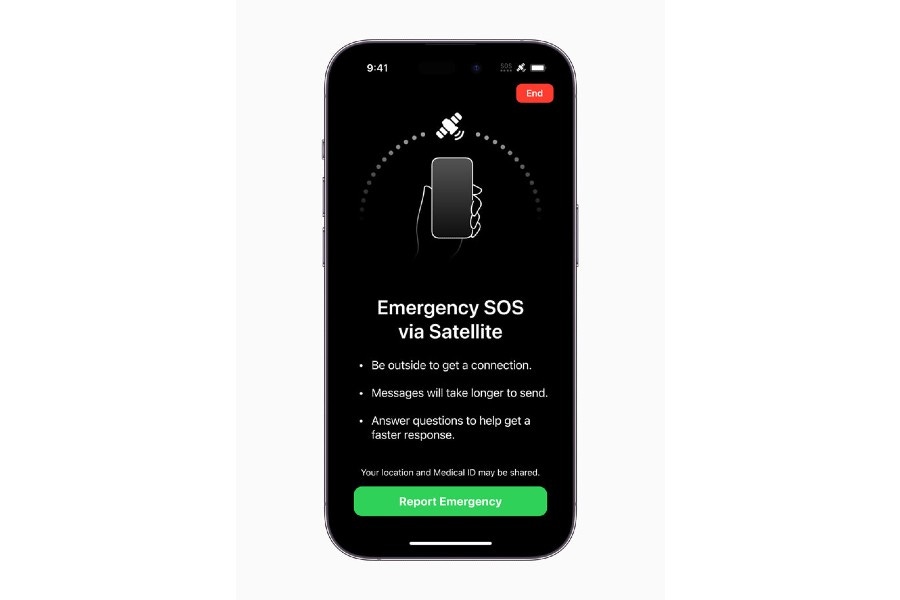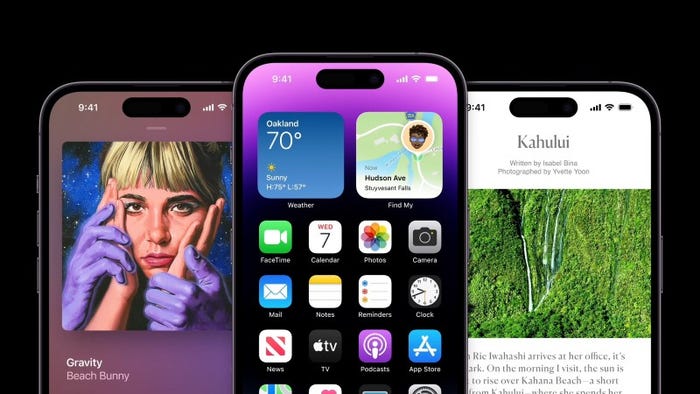Apple iPhone 14 Will Offer New Satellite Communications Feature
Apple’s new iPhones will offer incremental upgrades including enhanced camera and crash detection.
September 7, 2022

The only mystery leading into Apple’s iPhone 14 launch event was whether it would come with a price increase. Despite rising component costs, Apple did not raise the prices of its newest iPhones, which the company unveiled on Wednesday.
Apple held its annual iPhone refresh, which has become a post-Labor Day tradition, at its Cupertino, California, campus. It was Apple’s first live product launch for media and analysts since 2019, prior to the pandemic.
The launch featured four new iPhone models, three Apple watches and an upgraded version of Apple’s AirPod Pro earpieces. The new models include the base iPhone 14, with a 6.1-inch display, with a starting price of $799. The iPhone 14 Plus has a larger 6.7-inch display and costs $100 more. Apple’s premium models include the 6.1-inch iPhone 14 Pro and 6.7-inch iPhone 14 Max, starting at $999 and $1,099 respectively.
Apple will start taking orders for the new iPhone 14s on Friday and they are slated to ship next week.
Here’s our most recent list of new products and services that agents, VARs, MSPs and other partners offer. |
“These incredible products each offer so many great capabilities and work seamlessly together in a way that only Apple can deliver,” said Apple CEO Tim Cook. The new iPhone models come with typical incremental improvements such as longer battery life, better cameras and newer processors.
Improved Communications
One notable new feature is the way the devices will connect to wireless networks. The iPhone 14 models will no longer rely upon SIM cards. Instead, they will have digital eSIMs, which eliminate the need for a physical card. This will allow users to provision cellular services more easily, especially those who want to use the same phone with different carriers. Apple said eSIMs are more secure because if the iPhone is lost or stolen, the SIM can no longer be removed from the phone.
Another notable new communications feature is support for an emergency SOS text messaging service. If the device is out of range of Wi-Fi and 4G and 5G services, they can access a new satellite communications service Apple is launching.
 This capability took years to develop, because satellites travel at speeds of up to 50,000 miles per hour. Users need to move the antennas in the direction of the satellite. Also, antennas to access satellites are typically large, and users must point them in the direction of the satellite. Apple said it has developed custom components and software that enable the iPhone 14 models to connect to satellites. Because of the limited bandwidth of satellite messaging protocols, Apple had to develop a special message format.
This capability took years to develop, because satellites travel at speeds of up to 50,000 miles per hour. Users need to move the antennas in the direction of the satellite. Also, antennas to access satellites are typically large, and users must point them in the direction of the satellite. Apple said it has developed custom components and software that enable the iPhone 14 models to connect to satellites. Because of the limited bandwidth of satellite messaging protocols, Apple had to develop a special message format.
Apple will operate a ground relay stations that will route messages to the nearest and most appropriate emergency services provider. The service will launch in the U.S. and Canada in November, and Apple is offering it free for two years.
The new iPhones also have a new feature called Crash Detection, enabled by a new dual-core accelerometer. It can detect a severe auto collision and dial an emergency service if the driver is unconscious.
Apple said this feature uses existing components including the barometer, which detects cabin pressure changes, and GPS for sudden deceleration. It also uses AI-based motion algorithms trained with more than 1 million hours of crash record data. Apple is also introducing the Crash Detection feature in its new Apple Watch lineup.
Base Phone 14 and iPhone 14 Plus. The two base models are available in 6.1-inch and 6.7-inch screen sizes. Both have new 12 MP cameras, Apple’s True Depth front camera and a wide-angle camera with the company’s Photonic Engine for improved low-lite scenes. Apple claims the iPhone 14 will get up to 20 hours of battery life. The iPhone Plus battery is rated at 26 hours.
Premium iPhone 14 Pro. Apple’s higher-end models, the iPhone 14 Pro and iPhone 14 Pro Max, have Apple’s new A16 Bionic chip. The main camera has a 48 MP lens and a quad-pixel sensor. Apple’s Photonic Engine offers improved mid- to low-light performance enabled by new hardware and software.
The new models have 6-core CPUs with two high-performance cores and four high-efficiency cores. Apple claims the new A16 Bionic chip has a 5-core GPU with 50% more memory bandwidth. It also includes a new 16-core neural engine that Apple claims is capable of nearly 17 trillion operations per second.
New iOS 16. All the new iPhones will come with the latest version of Apple’s mobile operating system, iOS 16. The new OS sports a new lock screen that offers improved personalization with photos and widgets. Users can choose which information sources to present on the lock screen.
Apple also improved the iMessage feature, which allows users to edit or recall messages that they recently sent. Furthermore, a new Live Text feature is designed to recognized text within videos, convert currently and translate messages, among other features.
Want to contact the author directly about this story? Have ideas for a follow-up article? Email Jeffrey Schwartz or connect with him on LinkedIn. |
About the Author(s)
You May Also Like


